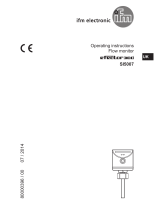
2
Contents
1 Preliminary note ���������������������������������������������������������������������������������������������������3
1�1 Symbols used ������������������������������������������������������������������������������������������������3
2 Safety instructions �����������������������������������������������������������������������������������������������3
3 Functions and features ����������������������������������������������������������������������������������������3
3�1 Applications ���������������������������������������������������������������������������������������������������4
4 Installation������������������������������������������������������������������������������������������������������������4
4�1 Use as a level sensor ������������������������������������������������������������������������������������4
4�1�1 Installation on tanks with a mounting adapter ��������������������������������������4
4�1�2 Installation on bybass pipes with a mounting adapter ��������������������������5
4�2 Use as proximity sensor ��������������������������������������������������������������������������������6
4�2�1 Installation and installation remarks �����������������������������������������������������6
4�2�2 Mounting adapter bore hole dimensions ����������������������������������������������7
4�2�3 Installation without a mounting adapter ������������������������������������������������7
4�2�4 Sensor bore hole dimensions ���������������������������������������������������������������8
5 Electrical connection ��������������������������������������������������������������������������������������������8
5�1 Wiring�������������������������������������������������������������������������������������������������������������8
6 Operating and display elements ��������������������������������������������������������������������������8
7 Settings ����������������������������������������������������������������������������������������������������������������9
7�1 IO-Link �����������������������������������������������������������������������������������������������������������9
8 Operation �������������������������������������������������������������������������������������������������������������9
9 Maintenance, repair, disposal ������������������������������������������������������������������������������9
10 Terms ���������������������������������������������������������������������������������������������������������������10











